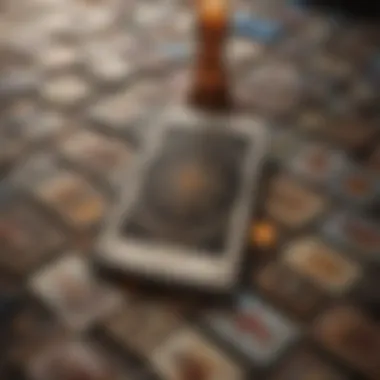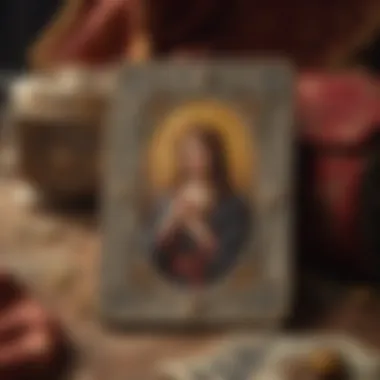Exploring Monthly Tarot: Practices and Insights


Intro
Monthly tarot readings are an insightful practice for individuals seeking deeper understanding of their lives and circumstances. These readings provide the opportunity to reflect on various aspects of existence, allowing for personal growth and awareness. With a historical context rooted in esoteric traditions, the methodology of performing these readings combines intuition and structured interpretation. This article will explore the significance of monthly tarot practices, emphasizing the techniques and insights they can yield.
By analyzing the interpretations specific to each tarot card and understanding their correlations with zodiac signs, practitioners can enhance their readings. Exploring tarot's connection with astrology also offers a richer layer of meaning, making monthly readings more profound. Thus, whether one is a novice or an experienced tarot reader, learning how to effectively interpret these cards within a structured framework is invaluable.
Understanding Monthly Tarot
In the realm of tarot, monthly readings hold a distinct significance. These readings provide a framework to reflect on upcoming influences and challenges, offering seekers a way to navigate the month ahead with insight. Monthly tarot sessions create a structured opportunity to engage with the cards, facilitating a deeper relationship between the reader and their intuition. This article will delve into why understanding monthly tarot readings is beneficial, emphasizing clarity, growth, and personal empowerment.
Defining Monthly Tarot Readings
Monthly tarot readings are generally conducted at the beginning of each month. The idea is to draw cards that signify the energies, themes, and potential occurrences for the next 30 days. This method is not just about random card selection; it requires intention and focus. Practitioners often create a specific atmosphere for these readings, using rituals or meditative practices to set the tone.
Common methods involve focusing on key aspects of life such as:
- Career
- Relationships
- Personal development
- Health
A reader may choose various spreads like the Three-Card Spread or the Monthly Wheel Spread to explore these aspects in-depth. Understanding how these readings work helps both new and experienced users to utilize the cards effectively, maximizing their potential for insight.
The Purpose of Monthly Readings
The primary purpose of monthly readings is to enhance one’s foresight and preparation. Rather than relying solely on chance, readers can actively engage with energies that may shape their future. This proactive stance encourages accountability. By interpreting the cards in the context of one’s life, seeker's can make informed decisions aligning with their goals and values.
Key advantages of conducting monthly tarot readings include:
- Insight into Potential Events: Provides foresight into challenges and opportunities.
- Self-Reflection: Encourages introspection, helping individuals assess their current situations.
- Intention Setting: Enables the formulation of actionable goals, linking personal aspirations with cosmic guidance.
- Empowerment: Cultivates a sense of control over one’s life path, reinforcing personal agency.
Monthly tarot readings serve as a compass, guiding individuals through the complexities of life while fostering deeper self-awareness.
The History of Tarot
The history of tarot is not simply a timeline of events; it is a rich tapestry interwoven with cultural significance, transformation, and the evolution of human thought. Understanding this history helps contextualize monthly tarot readings and reveals deeper meanings behind the cards. By exploring the origins and the progress of tarot through the ages, practitioners can draw connections between past interpretations and current practices. This foundation cultivates a more profound appreciation of the tarot as a tool for insight and reflection.
Origins of Tarot
The origins of tarot are shrouded in mystery and speculation. The first tarot cards appeared in Europe during the 15th century. Initially, these cards served as a game known as tarocchi, played among the nobility in Northern Italy. Unlike the spiritual tool they have become today, these early decks were more about gameplay than divination.
Tarot likely evolved from earlier card games that traveled with traders and soldiers. Some historians suggest a connection to ancient Egyptian hieroglyphs or the Chinese Game of the Ghosts. However, concrete evidence of these connections is lacking. Over time, tarot began to include allegorical imagery and symbolism, transforming from a mere pastime into a canvas for interpreting life’s complexities.
Tarot Through the Ages
As time progressed, tarot underwent considerable shifts in meaning and use. In the late 18th century, tarot gained a mystical reputation, thanks in part to figures like Antoine Court de Gébelin. He posited that the tarot had ancient Egyptian origins and was infused with esoteric wisdom. This assertion ignited a wave of interest in tarot as a divinatory tool.
In the 19th century, tarot became intertwined with occult practices, attracting enthusiasts drawn to mysticism. The Rider-Waite-Smith deck, created in 1909, popularized tarot symbols and made them accessible for self-exploration and guidance in personal decision making.
In contemporary times, tarot encompasses not only divination but also self-reflection, meditation, and psychological insight. Each deck reflects the beliefs and artistic expressions of its community. Cards now come in myriad designs, representing diverse philosophies and cultures.
The journey of tarot reflects the evolution of human consciousness. As practitioners explore their own readings, understanding this historical context enhances both their interpretations and their connection to the cards.
"History is the version of past events that people have decided to agree upon." - Napoleon Bonaparte


Embracing the varied historical interpretations of tarot enriches the experience. Practitioners can delve deeper into personal meanings while navigating the dynamics of monthly readings. This awareness not only enhances the quality of their practice but also underscores the enduring relevance of tarot in our evolving society.
The Structure of a Monthly Tarot Reading
Understanding the structure of a monthly tarot reading is vital for effective interpretation and meaningful insights. A well-structured reading allows the practitioner to approach the cards with clarity. It aids in focusing on the specific themes for the month ahead, whether they be emotional, financial, or relational. By establishing a framework, one can mitigate confusion and enhance the depth of analysis, allowing for a more profound understanding of the cards' messages.
Choosing the Right Deck
The selection of the tarot deck is a foundational aspect of any reading. Each deck has its unique symbolism and artistic style, which can resonate differently with each person. The choice of deck should align with the reader's intuition and purpose of the reading. For instance, someone focusing on emotional insights might prefer the lush imagery of the Lover's Tarot deck. Conversely, a more minimalistic deck, such as the Thoth Tarot, might be suitable for analytical or philosophical readings.
When choosing a deck, consider the following:
- Personal Resonance: How does the artwork and symbolism feel? Does it evoke a sense of connection?
- Reading Style: Are you more comfortable with traditional imagery or modern interpretations?
- Purpose of Reading: The nature of your inquiry may demand a specific type of representation in the cards.
Ultimately, the right deck should inspire confidence and creativity during readings, enhancing the overall experience and insight derived.
Selecting Cards for Monthly Insights
The selection of cards in a monthly reading can vary, but several approaches are commonly accepted. Each card drawn can reflect specific aspects of the month and can support the practitioner’s focus on particular questions or themes. One effective method is to establish a central theme before pulling cards. This theme can be based on personal intentions or broader goals for the upcoming month.
Here are several methods to select cards effectively for monthly insights:
- Intuitively Drawn Cards: Without overthinking, allow intuition to guide the selection process. This encourages a natural flow of insight.
- Pre-determined Positions: Assign each card a position representing a different area of life such as career, love, health, and personal growth.
- Card Shuffling Techniques: Familiarize yourself with various shuffling methods, such as the riffle shuffle or overhand shuffle, to maintain a sense of connection and energy with the deck.
Assess each card's meaning in relation to the month ahead. Consider how the card's attributes may influence various aspects of life. This technique can yield focused insights while supporting personal reflection as the month progresses.
"In tarot, each card acts as a mirror, reflecting aspects of the querent's life and psyche."
By effectively structuring the reading and choosing the right cards, practitioners become better equipped to navigate the complexities of the upcoming month. This approach not only enhances personal growth but also fosters a deeper connection to the tarot and one's own intuitive capabilities.
Techniques for Effective Monthly Readings
The effectiveness of monthly tarot readings hinges on structured techniques. Employing proper methods can enhance the clarity of insights and foster a more profound connection between the reader and the cards. Such techniques empower practitioners to navigate the complexities of their lives. It is essential to recognize that each approach provides distinct benefits, and integrating multiple techniques can lead to richer interpretations.
Card Spreads for Monthly Insights
Using card spreads is a fundamental aspect of effective tarot reading. They provide a framework, allowing readers to gain specific insights into various aspects of their life for the month ahead. Below are several notable spreads:
Three-Card Spread
The Three-Card Spread is renowned for its simplicity and versatility. It typically represents the past, present, and future. This straightforward arrangement allows the reader to quickly identify how past influences shape current situations and what potential outcomes may arise. The key characteristic of this spread is its adaptability. It is a beneficial choice for both novice and experienced readers. The uniqueness lies in its ability to streamline insights without overwhelming the practitioner with a myriad of information. However, one downside is the limited scope; more complex issues might require additional cards to fully understand.
Monthly Wheel Spread
The Monthly Wheel Spread is designed specifically to outline the energies and themes of an entire month. With positions representing each week or significant event, this spread provides a holistic view of the upcoming month. The key feature of this spread is its comprehensive nature, making it a preferred choice for tarot readers seeking in-depth month-long insights. The advantage here includes providing a visual roadmap for the individual, helping to set intentions for each week. Nevertheless, the complexity of the layout may be daunting for beginners, requiring practice to interpret effectively.
Long-Term Outlook Spread
The Long-Term Outlook Spread aims to extend insights beyond the current month. Typically encompassing several months or even up to a year, this spread helps readers understand ongoing trends and patterns. The primary characteristic is its forward-thinking perspective, which makes it a popular choice among seasoned readers. The unique aspect lies in its ability to connect current decisions with future implications, allowing users to consider long-term ramifications. However, the disadvantage of this spread can be its length; it might task readers with too much information at once, making it challenging to synthesize insights.
Intuitive Interpretation
Accompanying the structured card spreads, intuitive interpretation is a key technique in monthly tarot readings. This involves tapping into one's instinctive feelings and insights about the cards. Rather than sticking strictly to traditional meanings, readers can allow their personal experiences and emotions to shape their interpretation. This method encourages a deeper connection to the cards and how they resonate with the reader’s current context. While it can lead to highly personalized insights, a potential drawback is that it may introduce bias or inconsistency, necessitating a balance between intuition and established meanings.


Cultivating a blend of structured techniques and intuitive insight enriches the monthly tarot reading process, fostering a profound discovery of the self.
Integrating Monthly Tarot into Daily Life
Incorporating monthly tarot readings into daily life is essential for both spiritual growth and practical understanding. The insights garnered from tarot can influence decision-making, emotional health, and personal development. By making tarot a regular practice, individuals can gain clarity and direction that align with their personal goals and desires. This section delves into critical aspects of this integration, focusing on setting intentions and the practice of reflection.
Setting Intentions with Tarot
Setting intentions before conducting a tarot reading is a powerful practice. It allows the reader to focus on specific areas in life where clarity and guidance are sought. The intentions act as a lens through which the cards can be interpreted.
Before a reading, consider the following steps:
- Identify Key Areas: Focus on specific life aspects such as career, relationships, or personal growth.
- Articulate Intentions: Use clear, concise language to express what you wish to achieve through the reading. For example, "I seek guidance on my career path."
- Create a Calm Environment: Minimize distractions where the reading will take place. This could be lighting a candle or playing soft music.
When intentions are set, the reading takes on a more significant meaning. The cards drawn can then provide insights that are relevant to the desired outcome.
Reflection and Journaling
Reflection after a monthly tarot reading is crucial for assimilating the insights gained. Journaling not only serves to record interpretations but also helps to cement understanding of the guidance provided by the cards.
- Document the Reading: Write down the cards drawn, along with their positions and meanings. This documentation becomes a personal reference for future readings.
- Reflect on Interpretations: Take time to analyze what the readings mean in the context of personal life. Ask questions such as, "How does this insight apply to my current situation?"
- Track Progress: Revisit past readings regularly. This allows for the observation of patterns over time and can show how intentions have unfolded.
The process of reflection and journaling promotes continuous growth. As individuals learn from each reading, they can make informed changes in their lives based on tarot insights.
"Reflection through journaling amplifies the benefits of tarot, transforming insight into actionable steps."
Incorporating these practices into daily life allows for a meaningful relationship with tarot. Through intentional living and mindful reflection, one can gradually unfold the layers of personal insight that monthly tarot readings offer.
Common Challenges in Monthly Readings
When engaging with monthly tarot readings, practitioners may encounter various challenges that could hinder the clarity and effectiveness of their interpretations. Recognizing these challenges is vital to enhancing the insights gained from tarot. Addressing them not only helps in improving one’s reading skills but also ensures a more rewarding experience in the practice of tarot.
Misinterpretations and Overthinking
Misinterpretation is a common hurdle in tarot readings. Often, readers can bring personal biases into their interpretations, leading to skewed insights that may not accurately reflect the situation at hand. When faced with a card, especially one that resonates with intense emotions or complex scenarios, it's easy to overanalyze its meaning. This overthinking can inhibit intuition, causing a cycle of self-doubt and confusion.
- Clarity Over Complexity: Seeking clarity should be the primary goal during a reading. It is essential to focus on the basic meanings of the cards, without getting lost in excessive detail.
- Trust Your Intuition: Practitioners should rely on their intuition as a guiding force. An instinctual grasp of a card’s relevance often supersedes analytical reasoning. Fostering this intuition is key to more coherent readings.
- Journaling Insights: Keeping a journal of readings may help identify recurring themes and personal patterns, reducing the likelihood of misinterpretation over time.
"The journey of tarot is as much about understanding oneself as it is about interpreting the cards."
Emotional Bias in Reading
Emotional bias can significantly influence how tarot readings are perceived and interpreted. Readers who are emotionally invested in a particular outcome may unconsciously allow their feelings to dictate the narrative of the reading. This can lead to an overly optimistic or pessimistic perspective that distorts the message of the cards.
- Awareness of Emotions: It is crucial for practitioners to be aware of their emotional state before and during a reading. This awareness can help in separating personal feelings from the insights provided by the tarot.
- Objectivity in Practice: Striving for objectivity can lead to stronger and more reliable interpretations. Engaging with the cards as an outsider can promote a fresh perspective.
- Seek External Feedback: Discussing readings with trusted peers can provide additional viewpoints, helping to counteract emotional biases.
By acknowledging these common challenges in monthly tarot readings, practitioners can implement strategies for overcoming them. This awareness not only cultivates a deeper understanding of tarot but also enhances the ability to provide meaningful guidance by fostering a healthier relationship with the cards.
Ethical Considerations in Tarot Practice
Ethics form the backbone of tarot practice, shaping the interaction between the reader and the client. By understanding and implementing ethical considerations, practitioners can cultivate a respectful and nurturing environment. In tarot readings, where emotions often run high, the importance of ethics cannot be overstated. This section explores significant aspects essential for maintaining integrity in monthly tarot readings.
Respecting Client Boundaries


Establishing clear boundaries is vital for any tarot reader. Each client arrives with unique emotions, experiences, and expectations. It is critical to affirm that tarot readings are not a replacement for professional advice, such as legal or psychological assistance. Prior to any session, practitioners should communicate the reading's purpose, limitations, and anticipate questions. This transparency fosters trust and lets clients feel safe.
Additionally, the tarot reader should be attentive to verbal and non-verbal cues during the session. If a client appears uncomfortable or hesitant, it’s critical to readjust the focus or change the subject. A good practice is to check in with clients throughout the session, confirming they are comfortable. This responsiveness shows respect and sensitivity to their boundaries.
"An ethical tarot reader respects the autonomy of their clients and provides them with the space to voice their concerns."
Providing Empowering Guidance
An essential aspect of ethical tarot practice is to empower clients rather than create dependency. The role of a tarot reader should not be to offer definitive answers, but rather to guide clients towards self-discovery and deeper understanding. An empowering reading encourages clients to consider the insights gained and use that knowledge to make informed decisions in their lives.
During consultations, a reader could emphasize personal agency. For instance, instead of predicting a fixed outcome, they can present the possible paths based on the card interpretations. Encouraging open dialogue enhances this notion of empowerment.
Practitioners should also be cautious with language. Certain wording can evoke fear or anxiety, which does not promote a healthy mindset. Framing messages positively can lead to a more constructive experience. For example, if a card suggests challenges, it can be paired with strategies for overcoming them, fostering a proactive approach.
Resources for Monthly Tarot Enthusiasts
The exploration of tarot practices is enriched significantly by access to various resources. These materials can provide deeper insight and foster growth among enthusiasts at any level. Having the right tools at one’s disposal is vital for personal development and understanding of the tarot's complex narratives and symbols. Moreover, learning from a diverse set of voices in the tarot community opens avenues for fresh interpretations and practices.
Books and Literature
Books and literature are cornerstone resources for anyone serious about mastering the art of tarot, particularly for monthly readings. Classic works, such as The Pictorial Key to the Tarot by Arthur Edward Waite and 78 Degrees of Wisdom by Rachel Pollack, serve as foundational texts. These books provide essential histories and detailed explanations of card meanings, which can contextualize monthly readings more effectively.
Modern texts also contribute to this rich tapestry. Works like The Tarot Bible by Sarah Bartlett offer practical advice and interpretations that are invaluable. They usually contain examples of spreads and case studies that help practitioners comprehend practical applications. This continued learning is beneficial for refining intuitive skills.
To maximize the understanding of tarot literature:
- Study Different Authors: No two authors think alike. By reading various perspectives, the practitioner can adapt methods that resonate with them.
- Participate in Book Clubs: Joining or forming a tarot book club allows for shared insights and different viewpoints.
- Create a Reading List: A planned approach can ensure that you do not miss key texts in the evolving world of tarot.
Online Communities and Forums
The integration of online communities and forums into tarot practice offers a dynamic space for discussion and support. Websites like Reddit, particularly the Tarot subreddit, has extensive threads dedicated to shared experiences and advice. Participants can openly exchange readings, ask questions, and receive feedback. This interactive aspect of community learning promotes a sense of belonging and collective wisdom.
Facebook groups also function as vibrant hubs for tarot enthusiasts. These groups often facilitate discussions that can range from beginner tips to advanced techniques. Being part of these communities can serve several purposes:
- Networking: Connect with fellow practitioners, share personal journeys, and even collaborate on events or readings.
- Resource Sharing: Members often share e-books, articles, and links to insightful content that can enhance overall knowledge.
- Mentorship Opportunities: Experienced readers frequently offer guidance and can help newer practitioners develop a stronger understanding of the material.
Finale
The conclusion serves as an essential capstone to the exploration of monthly tarot readings. It synthesizes the diverse elements discussed throughout the article, underscoring the significance of structured introspection through tarot. Monthly readings offer both a ritualistic framework and a practical approach to navigating the complexities of life. It is a time for reflection, enabling practitioners to assess their goals and challenges in a more focused manner.
Summarizing the Journey of Monthly Tarot
The journey of monthly tarot is both illuminating and transformative. Throughout this article, we have navigated the distinct aspects of monthly tarot readings, from their historical roots to practical techniques for effective interpretation. Each section serves to build your understanding of how tarot may function as a tool for deeper self-awareness and clarity. As practitioners engage with their cards, they develop a heightened sense of intuition, benefiting from the dialogue between the mind and the symbols presented on the cards. A well-structured reading guides not only the querent but also the reader, fostering a deeper connection to the energies at play.
Essentially, summarizing this journey highlights the following points:
- Technique: The right methods, such as specific spreads, pave the way for clearer insights.
- Intuition: Trusting one’s gut feelings enhances interpretations beyond mere card meanings.
- Routine: Consistency fosters familiarity, making each reading more impactful over time.
"Tarot is not about predicting a set future but understanding potential paths in relation to your present actions."
Encouragement for Continued Exploration
Encouragement resonates strongly as we conclude this discussion. Continuing the exploration of monthly tarot not only enriches one’s personal practice but expands the shared collective knowledge of tarot as an art form. Engaging with online communities such as Reddit or exploring the works of dedicated tarot authors will enhance one’s skill set. Additionally, setting aside time for regular practice supports your ongoing growth as a reader.
There are many avenues for further exploration:
- Experimenting with different tarot decks to perceive new interpretations.
- Joining forums on platforms like Facebook that cater to tarot enthusiasts.
- Reading literature that delves into advanced interpretations, such as esoteric texts or historical analyses found on Britannica.
Ultimately, the more you delve into the art, the more you discover about the self and the intricate weave of life. Monthly tarot can become a compelling journey of self-discovery, offering insights that are rich and varied, capable of shedding light on the paths one may take.







